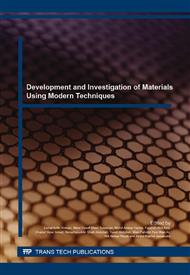[1]
Holbrook, M. Radon: A Public Health Risk. Indiana State Nurses Association Bulletin, (2014).
Google Scholar
[2]
S.A. Saidi, M.S. Jaafar, M.K.A.A. Razab, and N.N. Zulkepli, A Study of Radon-222 Levels in Foamed Light Concrete. Australian Journal of Basic and Applied Sciences, 7 (2013) 315-318.
Google Scholar
[3]
S.A. Saidi, Faktor Emanasi Rn-222 Daripada Bahan Konkrit Ringan Berbusa Dalam Ruang Prototaip. Unpublished Ph. D Thesis, Universiti Sains Malaysia, Penang, (2014).
Google Scholar
[4]
J.J. Bevelacqua. Contemporary health physics: problems and solutions: John Wiley & Sons (2009).
Google Scholar
[5]
J.E. Martin, Radiation Shielding Physics for Radiation Protection: A Handbook, Second Edition, John Wiley & Sons, (2008).
Google Scholar
[6]
S. Darby, D. Hill, A. Auvinen, J. Barros-Dios, H. Baysson, F. Bochicchio, H. Deo, R. Falk, F. Forastiere and M. Hakama, Radon in homes and risk of lung cancer: collaborative analysis of individual data from 13 European case-control studies. Bmj. 330 (2005).
DOI: 10.1136/bmj.38308.477650.63
Google Scholar
[7]
B. Almayahi, R.O. Hussein, H.H. Hussain, A.K. Alsaedi, A. Alasadi, & A.S. Ali, Bricks Rn-222 Exhalation Rates in Some Samples from Different Countries, World Appl. Sci. J. 29(6) (2014) 706-709.
DOI: 10.14445/22315381/ijett-v7p255
Google Scholar
[8]
A. Abdallah, M. Mohery, S.J. Yaghmour, & S. Alddin, Radon exhalation and natural radiation exposure in low ventilated rooms, Radia. Phys. Chem. 81(11) (2012) 1710-1714.
DOI: 10.1016/j.radphyschem.2012.07.004
Google Scholar
[9]
B. Sahoo, B. Sapra, J. Gaware, S. Kanse, & Y. Mayya, A model to predict radon exhalation from walls to indoor air based on the exhalation from building material samples, Sci. Total Environ. 409(13) (2011) 2635-2641.
DOI: 10.1016/j.scitotenv.2011.03.031
Google Scholar
[10]
A. Kumar, R. Chauhan, M. Joshi, & B. Sahoo, Modeling of indoor radon concentration from radon exhalation rates of building materials and validation through measurements, J. Environ. Radioact. 127 ( 2014) 50-55.
DOI: 10.1016/j.jenvrad.2013.10.004
Google Scholar
[11]
R. W. Field, D.J. Steck, C.F. Lynch, C.P. Brus, J.S. Neuberger and B.C. Kross, . Residential radon-222 exposure and lung cancer: exposure assessment methodology. Journal of Exposure Analysis and Environmental Epidemiology, 6 (1996)181-195.
DOI: 10.1093/oxfordjournals.aje.a010153
Google Scholar
[12]
T. Godish, (2010). Indoor environmental quality: CRC Press LLC. Florida, USA.
Google Scholar
[13]
W.H. Organization, WHO handbook on indoor radon: a public health perspective, World Health Organization, (2009).
Google Scholar
[14]
C. Man, & H. Yeung, Radioactivity contents in building materials used in Hong Kong, J. Radioanal. Nucl. Chem. 232(1-2) (1998) 219-222.
DOI: 10.1007/bf02383742
Google Scholar
[15]
G. Keller, B. Hoffmann, & T. Feigenspan, Radon permeability and radon exhalation of building materials, Sci. Total Environ. 272 (2001) 85-89.
DOI: 10.1016/s0048-9697(01)00669-6
Google Scholar
[16]
P. Bossew, The radon emanation power of building materials, soils and rocks, Appl. Radiat. Isot. 59 (2003) 389-392.
DOI: 10.1016/j.apradiso.2003.07.001
Google Scholar
[17]
C. Cosma, A. Cucoş-Dinu, B. Papp, R. Begy, C. Sainz, Soil and building material as main sources of indoor radon in Băiţa-Ştei radon prone area (Romania), J. Environ. Radioact. 116 (2013) 174-179.
DOI: 10.1016/j.jenvrad.2012.09.006
Google Scholar
[18]
A. Sakoda,Y. Nishiyama, K. Hanamoto, Y. Ishimori, Y. Yamamoto, T. Kataoka, A. Kawabe, K. Yamaoka, Differences of natural radioactivity and radon emanation fraction among constituent minerals of rock or soi, Appl. Radiat. Isot. 68 (2010).
DOI: 10.1016/j.apradiso.2010.04.025
Google Scholar
[19]
J. W. Washington, and A.W. Rose, Regional and temporal relations of radon in soil gas to soil temperature and moisture, Geophys. Res. Lett. 17 (1990) 829-832.
DOI: 10.1029/gl017i006p00829
Google Scholar


